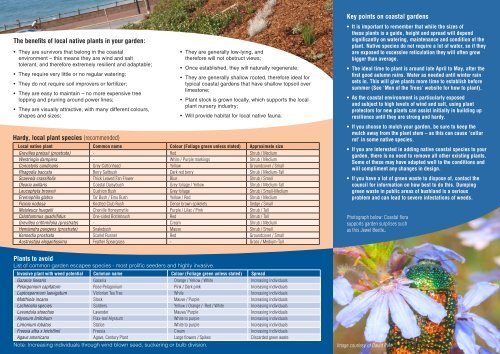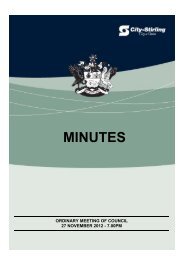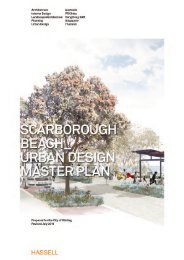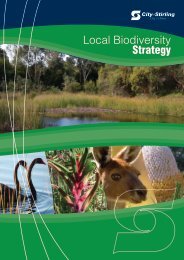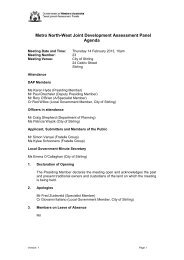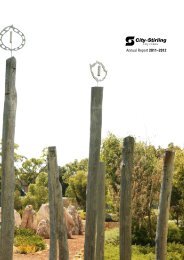An Introduction to Coastal Gardens - City of Stirling
An Introduction to Coastal Gardens - City of Stirling
An Introduction to Coastal Gardens - City of Stirling
Create successful ePaper yourself
Turn your PDF publications into a flip-book with our unique Google optimized e-Paper software.
The benefits <strong>of</strong> local native plants in your garden:<br />
• They are survivors that belong in the coastal<br />
environment – this means they are wind and salt<br />
<strong>to</strong>lerant, and therefore extremely resilient and adaptable;<br />
• They require very little or no regular watering;<br />
• They do not require soil improvers or fertilizer;<br />
• They are easy <strong>to</strong> maintain – no more expensive tree<br />
lopping and pruning around power lines;<br />
• They are visually attractive, with many different colours,<br />
shapes and sizes;<br />
Hardy, local plant species (recommended)<br />
Local native plant Common name Colour (Foliage green unless stated) Approximate size<br />
Grevillea preissii (prostrate) - Red Shrub / Medium<br />
Westringia dampiera - White / Purple markings Shrub / Medium<br />
Conostylis candicans Grey Cot<strong>to</strong>nhead Yellow Groundcover / Small<br />
Rhagodia baccata Berry Saltbush Dark red berry Shrub / Medium-Tall<br />
Scaevola crassifolia Thick Leaved Fan Flower Blue Shrub / Small<br />
Olearia axillaris <strong>Coastal</strong> Daisybush Grey foliage / Yellow Shrub / Medium-Tall<br />
Leucophyta brownii Cushion Bush Grey foliage Shrub / Small-Medium<br />
Eremophila glabra Tar Bush / Emu Bush Yellow / Red Shrub / Medium<br />
Ficinia nodosa Knotted Club Rush Dense brown spikelets Sedge / Small<br />
Melaleuca huegelii Chenille Honeymyrtle Purple / Lilac / Pink Shrub / Tall<br />
Calothamnus quadrifidus One-sided Bottlebrush Red Shrub / Tall<br />
Grevillea crithmifolia (prostrate) - Cream Shrub / Medium<br />
Hemiandra pungens (prostrate) Snakebush Mauve Shrub / Small<br />
Kennedia prostrata Scarlet Runner Red Groundcover / Small<br />
Austrostipa elegantissima Feather Speargrass - Grass / Medium-Tall<br />
Plants <strong>to</strong> avoid<br />
List <strong>of</strong> common garden escapee species - most prolific seeders and highly invasive.<br />
• They are generally low-lying, and<br />
therefore will not obstruct views;<br />
• Once established, they will naturally regenerate;<br />
• They are generally shallow rooted, therefore ideal for<br />
typical coastal gardens that have shallow <strong>to</strong>psoil over<br />
limes<strong>to</strong>ne;<br />
• Plant s<strong>to</strong>ck is grown locally, which supports the local<br />
plant nursery industry;<br />
• Will provide habitat for local native fauna.<br />
Invasive plant with weed potential Common name Colour (Foliage green unless stated) Spread<br />
Gazania linearis Gazania Orange / Yellow / White Increasing individuals<br />
Pelargonium capitatum Rose Pelagonium Pink / Dark pink Increasing individuals<br />
Lep<strong>to</strong>spermum laevigatum Vic<strong>to</strong>rian Tea Tree White Increasing individuals<br />
Matthiola incana S<strong>to</strong>ck Mauve / Purple Increasing individuals<br />
Lachenalia species Soldiers Yellow / Orange / Red / White Increasing individuals<br />
Lavandula s<strong>to</strong>echas Lavender Mauve/ Purple Increasing individuals<br />
Alyssum linifolium Flax-leaf Alyssum White <strong>to</strong> purple Increasing individuals<br />
Limonium lobatus Statice White <strong>to</strong> purple Increasing individuals<br />
Freesia alba x leichtlinii Freesia Cream Increasing individuals<br />
Agave americana Agave, Century Plant Large flowers / Spikes Discarded green waste<br />
Note: Increasing individuals through wind blown seed, suckering or bulb division.<br />
Key points on coastal gardens<br />
• It is important <strong>to</strong> remember that while the sizes <strong>of</strong><br />
these plants is a guide, height and spread will depend<br />
significantly on watering, maintenance and condition <strong>of</strong> the<br />
plant. Native species do not require a lot <strong>of</strong> water, so if they<br />
are exposed <strong>to</strong> excessive reticulation they will <strong>of</strong>ten grow<br />
bigger than average.<br />
• The ideal time <strong>to</strong> plant is around late April <strong>to</strong> May, after the<br />
first good autumn rains. Water as needed until winter rain<br />
sets in. This will give plants more time <strong>to</strong> establish before<br />
summer (See ‘Men <strong>of</strong> the Trees’ website for how <strong>to</strong> plant).<br />
• As the coastal environment is particularly exposed<br />
and subject <strong>to</strong> high levels <strong>of</strong> wind and salt, using plant<br />
protec<strong>to</strong>rs for new plants can assist initially in building up<br />
resilience until they are strong and hardy.<br />
• If you choose <strong>to</strong> mulch your garden, be sure <strong>to</strong> keep the<br />
mulch away from the plant stem – as this can cause ‘collar<br />
rot’ in some native species.<br />
• If you are interested in adding native coastal species <strong>to</strong> your<br />
garden, there is no need <strong>to</strong> remove all other existing plants.<br />
Some <strong>of</strong> these may have adapted well <strong>to</strong> the conditions and<br />
will compliment any changes in design.<br />
• If you have a lot <strong>of</strong> green waste <strong>to</strong> dispose <strong>of</strong>, contact the<br />
council for information on how best <strong>to</strong> do this. Dumping<br />
green waste in public areas <strong>of</strong> bushland is a serious<br />
problem and can lead <strong>to</strong> severe infestations <strong>of</strong> weeds.<br />
Pho<strong>to</strong>graph below: <strong>Coastal</strong> flora<br />
supports garden surprises such<br />
as this Jewel Beetle.<br />
Image courtesy <strong>of</strong> David Pike


